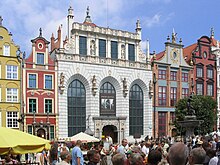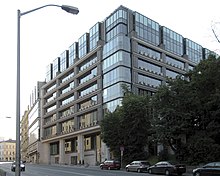This is an old revision of this page, as edited by Eastmaz (talk | contribs) at 21:51, 27 July 2011 (Updating the number of companies listed, as of 27 July 2011). The present address (URL) is a permanent link to this revision, which may differ significantly from the current revision.
Revision as of 21:51, 27 July 2011 by Eastmaz (talk | contribs) (Updating the number of companies listed, as of 27 July 2011)(diff) ← Previous revision | Latest revision (diff) | Newer revision → (diff)| WSE logo | |
| Company type | Joint stock company |
|---|---|
| Founded | 12 April 1991 |
| Headquarters | Warsaw, Poland |
| Key people | Ludwik Sobolewski, President, Management Board |
| Website | www.wse.com.pl |
The Warsaw Stock Exchange (WSE), Template:Lang-pl, is a stock exchange located in Warsaw, Poland. It has a capitalization of € 220 bln (as of April 2011).
The WSE is a member of the World Federation of Exchanges and the Federation of European Securities Exchanges.
History







Kingdom of Poland
Warsaw became the capital and financial center of Poland in the early 17th century. In the Middle Ages other Polish towns, most of them members of the Hanse, were the leading economic centers of Poland. Merchants from western and southern Europe settled in Poland since the beginning of Polish statehood. They brought the system of organized exchange trading in securities, mostly bills and currencies, to Poland. The oldest Polish bill was issued in 1243 by the Cuyavien bishop Sambor. The main centers of securities tradings were at the lower Vistula, in the 14th century occupied by the Teutonic Knights. The first marcantile exchanges emerged in Gdańsk (1379), Toruń (1385), Malbork (14th century), Kraków (1405), Poznań (1429), Zamość (1590), Królewiec (1613) and Elbląg (1744). Mediaeval mercantile exchanges might have also existed for a short period in Chełmno, Grudziądz and Braniewo.
Polish-Lithuanian Commonwealth
Early mercantile trade in securities emerged in Warsaw in the 15th and 16th century and was based on privileges by the Masovian Dukes and later Polish Kings. The original privileges are lost, but they have been mentioned and affirmed by King John II Casimir in 1658. An archetype of the Warsaw Exchange was first mentioned in 1624/1625. In 1643 Adam Zarzebski, the chief architect of King Władysław IV, mentioned a stone building on the Old Market Square as the seat of the Exchange, probabely a part of the Old Town Hall. The securities trading minutes of the Warsaw merchants in the Old Town Hall have been recorded since 1757. The legal framework for the trading in securities was first codified by the Polish Sejm in 1775. As one of the first Polish corporations Kompania Manufaktur Welnianych issued its first 120 shares in 1768. The first Polish bonds were issued in 1782 by King Stanisław August.
Duchy of Warsaw
In 1808 the Duchy of Warsaw adopted the Napoleonic code including the Code de Commerce. The Code de Commerce also regulated stock exchange law and there were efforts made to establish an state-organized exchange on the basis of this code in Warsaw. However, due to the Napoleonic Wars and the Congress of Vienna, the plans had to be postponed.
Congress Poland
The first state-organized exchange in Poland, the Warsaw Mercantile Exchange (Gielda Kupiecka w Warszawie), was established in Warsaw by a decree of viceregent Grand Duke Constantine Romanov dated 12 May 1817. The first trading took place in the Old Town Hall on 16 May 1817 and moved in the same year to the Saxon Palace as the Old Town Hall was destroyed in the same year. Exchange trading in securities also was held in the trading house Marywil but were moved to the house of building of the Polish Central Bank in 1828 and to the building of the Financial Commission and Confraternity Harmonia in 1876, before in 1877 the Warsaw Mercantile Exchange moved into its own building at the Saxon Garden.
The Warsaw Mercantile Exchange grew rapidly. The number of brokers doubled between 1817 and 1822. In the first half of the 19th century mainly bills, debentures and bonds were traded, while share trading on a broader scale developed in the second half of that century. The first public security to be traded on the Warsaw Mercantile Exchange was the debentures of Towarzystwo Kredytowe Ziemskie issued in 1826. The first shares admitted to trading were issued by railroad companies in the 1840s. Until 1853 trading sessions were twice a week between 1pm and 2pm. In 1873 a new, more liberal, stock exchange act was passed, separating the trade in securities and commodities. A separate Warsaw Commodities Exchange was founded in 1874. Central Europe was subject to a big bull market after the Prussian-Franco War of 1870-1871, followed by a harsh crash starting at the Vienna Stock Exchange in the later 1870s. However, the Warsaw Mercantile Exchange constantly grew until the First World War. In 1915 Warsaw was occupied by German and Austrian forces and the exchange was closed down during the later years of the war.
Second Polish Republic
The Warsaw Money Exchange (Gielda Pieniężna w Warszawie) was reopened after the First World War in 1919 and again in 1921. Between 1919 and 1939, the Warsaw Money Exchange was by far the largest of several bourses in different Polish cities (Katowice, Kraków, Lwów, Łódź, Poznań and Wilno), and accounted for 95 % of the volume and 65 to 85 % of the transactions traded on the Polish capital market. The Warsaw Money Exchange had more than 150 participants, 25 brokers, and more than 130 issuers. Its yearly turnover amounted to 1 billion PLZ. A new stock exchange law was passed in 1921 and again in 1926 and 1935. The Polish exchanges were subject to the world crises of 1929, but they recovered in the second half of the 1930s until the Second World War. In 1939 Poland was occupied by German and Russian forces and all Polish stock exchanges were closed by the aggressors.
Third Polish Republic
It was only after the fall of the communist regime in 1989, that the Warsaw Stock Exchange could be reestablished. Much needed experience and financial aid was provided by France (especially the Société des Bourses Françaises). The WSE began activity in its present form on 16 April 1991. On the first trading day only five stocks were listed (Tonsil, Próchnik, Krosno, Kable, and Exbud). Seven brokerages took part in the trading, and there were 112 buy and sell orders, with a turnover of only 1,990 złotys ($2,000).
In the years 1991–2000, the stock exchange was located in the building which during the previous, and then recent, communist years had been the seat of the Central Committee of the ruling Polish Communist Party. This can be considered an interesting reflection on the rapid transition of Poland from a communist to a market economy.
Since then the WSE has been developing and growing rapidly and is now perceived as well established on the European market. In September 2008 the stock exchange was recognized as an "Advanced Emerging" exchange by FTSE, alongside markets from such countries as South Korea or Taiwan.
Legal framework
The legal framework for exchange operations is provided by three acts from 29 July 2005:
- Act on Public Offering, Conditions Governing the Introduction of Financial Instruments to Organised Trading, and Public Companies
- Act on Trading in Financial Instruments
- Act on Capital Market Supervision
Additionally, the WSE is governed by the Code of Commercial Companies of 2000, the Statutes of the Warsaw Stock Exchange, the Rules of the Warsaw Stock Exchange, and the Rules of the Stock Exchange Court.
Structure and operations
The WSE is a joint stock company founded by the State Treasury. It is divided into about 60,000 registered shares of 700 złotys each. The Treasury holds the largest stake (almost 99%), with the rest divided among several dozen entities, including banks and brokerage houses.
The following instruments are traded on the WSE: shares, bonds, subscription rights, allotments, and derivatives such as futures, options, and index participation units.
Since its inception, the WSE has engaged in electronic trading. The WARSET trading platform has been in use since November 2000. An additional market called NewConnect was introduced on 30 August 2007.
The exchange has pre-market sessions from 08:00am to 09:00am, normal trading sessions from 09:00am to 04:20pm and post-market sessions from 04:20pm to 04:30pm on all days of the week except Saturdays, Sundays and holidays declared by the Exchange in advance.
Statistics
- Number of companies listed: 419 (27 July 2011)
- Market value of listed shares (November 2010): 812,646 bln PLN (206,601 bln EUR)
- Market value of Polish companies: 547,216 bln PLN (139,120 bln EUR)
- Volume of stocks traded in 2009: 351,885 bln PLN ( 84,996 bln EUR)
Stock market indices
There are fifteen indices on the WSE.
- WIG
- WIG20
- mWIG40
- sWIG80
- WIG-BANKI
- WIG-BUDOW
- WIG-CHEMIA
- WIG-DEWEL
- WIG-ENERG
- WIG-INFO
- WIG-MEDIA
- WIG-PALIWA
- WIG-PL
- WIG-SPOZYW
- WIG-SUROWCE
- WIG-TELKOM
See also
- List of stock exchanges
- List of European stock exchanges
- Polish Financial Supervision Authority
- NewConnect
References
External links
- Warsaw Stock Exchange
- Warsaw Stock Exchange at the World Federation of Exchanges
- NewConnect
- WSEInfoSpace
Categories: